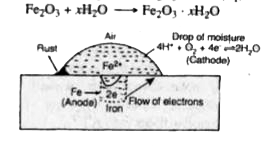Discuss the electrochemical theory of rusting.
Text Solution
The rusting of iron can be explained on the basis of electrochemical theory which involves oxidation and reduction reaction. According to this theory, it is believed that non-uniform surface of metal or impurities present in iron behaves like small electric cells (called corrosion couples) in the presence of water containing dissolved oxygen or carbon dioxide. A film of moisture with dissolved CO2 acts as electrolytic solution covering the metal surface at various places.
In these small electrolytic cells, pure ion acts as anode while cathodes are impure portions. The overall rusting involves the following steps :
Oxidation occurs at the anodes of each electrochemical cell. Therefore, at each anode iron is oxidised to Fe2+ ions.
At anode
Fe(s)→Fe2+(aq)+2e− ......(i)
hus, the metal atoms in the lattice pass into the solution as ions, leaving electrons on the metal itself. These electrons move towards the cathode region through the metal.
At the cathode of each cell, the electrons are taken up by hydrogen ions (reduction takes place). The H+ ions are obtained either from water or from acidic substances in water :
H2O⇔H++OH− ......(ii)
or CO2+H2O→H+HCO−3 ......(iii)
At cathode :
H++e−→H ......(iv)
The hydrogen atoms on the iron surface reduce dissolved oxygen.
4H+O2→2H2O ......(v)
Therefore, the overall reaction at cathode of different electrochemical cells may be written as
4H+(aq)+O2(g)+4e−→2H2O(l) ......(vi)
The overall redox reaction may be written by multiplying reaction at anode, Eq. (i) by 2 and adding reaction at cathode Eq. (iv) to equalise number of electrons lost and gained, i.e.,
Oxidation half reaction
Fe(s)→Fe2+(aq)+2e]×2
Reduction half reaction
4H+(aq)+O2(g)+4e−→2H2O(l)
Overall cell reaction
2Fe2++4H+(aq)+O2(g)→2Fe2+(aq)+2H2O(l)
The ferrous ions are oxidized further by atmospheric oxygen to Fe2+ (as Fe2O3 and form rust
4Fe2++O2(g)+4H2O→2Fe2O3+8H+ and Fe2O3+xH2ORust→2Fe2O3.xH2O
The H+ ions produced above are also used for reaction (iv).
4Fe2++O2+4H2O→2Fe2O3+8H+(aq)
Fe2O3+xH2O→Fe2O3.xH2O

|
Topper's Solved these Questions
- ELECTROCHEMISTRYBOOK - MBD -HARYANA BOARDCHAPTER - ELECTROCHEMISTRYEXERCISE - SHORT ANSWER TYPE QUESTIONS
37 Videos
- CHEMISTRY IN EVERYDAY LIFEBOOK - MBD -HARYANA BOARDCHAPTER - CHEMISTRY IN EVERYDAY LIFEEXERCISE - Long answer type questions
5 Videos
- GENERAL PRINCIPLES AND PROCESSES OF ISOLATION OF ELEMENTS BOOK - MBD -HARYANA BOARDCHAPTER - GENERAL PRINCIPLES AND PROCESSES OF ISOLATION OF ELEMENTS EXERCISE - LONG ANSWER TYPE QUESTIONS
3 Videos
Similar Questions
Knowledge Check
On the basis of electrochemical theory of aqueous corrosion, the reaction occurring at the cathode is
AO2(g)+4H+(aq)+4e−→2H2O(l)BFe(s)→Fe2+(aq)+2e−CFe2+(aq)→Fe3+(aq)+e−DH2(g)+2OH−(aq)→2H2O(l)+2e−In electrochemical corrosion of metals, the metal undergoing corrosion
AanodeBcathodeCneither anode or cathodeDneither anode or cathode depending upon its standard reduction potentialIn an aqueous solution the reaction occurs at the cathode, on basis of electrochemical theory of corrosion is
AO2(g)+4H+(aq)+4e−→2H2O(1)BH2(g)+2OH−(aq)→2H2O(1)+2e−CFe(s)→Fe2+(aq)+2e−DFe2+(aq)→Fe3+(aq)+e−
What is corrosion? Describe the electrochemical phenomenon of rusting of iron
View SolutionDiscuss the modern synthetic theory of evolution.
View SolutionDiscuss the process of rusting of iron.
View SolutionOn the basis of electrochemical theory of aqueous corrosion, the reaction occurring at the cathode is
View SolutionAccording to electrochemical theory the metal which rusting take place as a result of
View Solution
